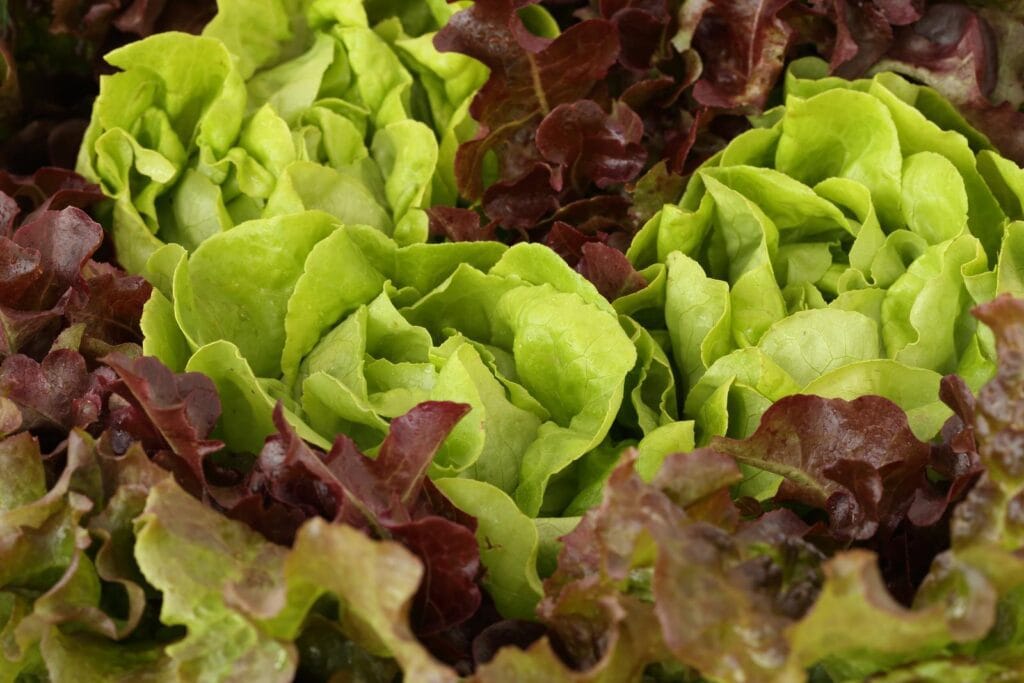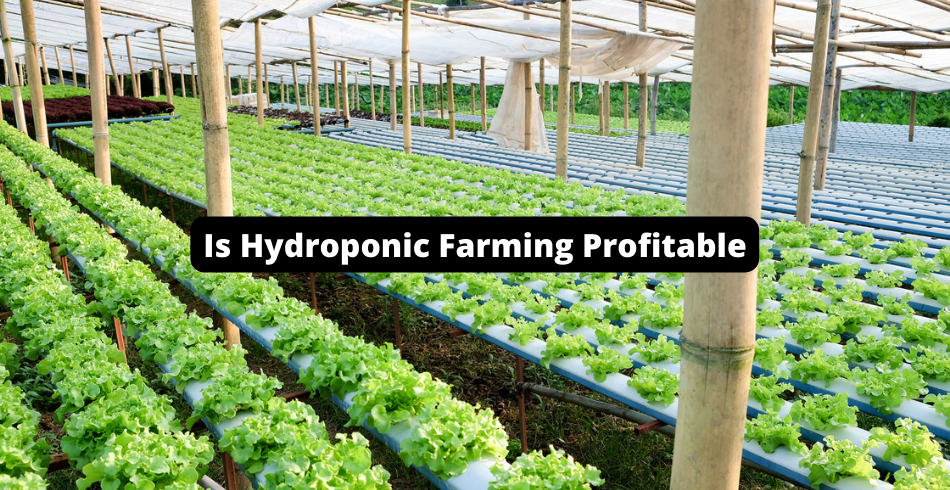Hydroponic farming is high-tech agriculture where plants are grown in nutrient-dense water instead of soil.
A hydroponic farming system has become increasingly popular in recent years, allowing farmers to grow crops in areas that couldn’t support traditional agriculture.
While this farming has taken the world by storm, many wonder if it’s even profitable or sustainable long term.
Hydroponic Farming Is Profitable; a little over half (50%) of all hydroponic farms make a profit.
Not only is it profitable, but some companies are making MILLIONS using a couple of simple tricks.
Let’s jump in.

How Much Money Can a Hydroponic Farm Make?
The amount of money you can make with hydroponics depends on how much land and labor you can deploy.
With an increase in land and labor, you can harvest more plants. This drives up the revenue you will make, thus increasing your profits.
Hydroponic farms scale much better than traditional farms. This is because hydroponic farms use a closed-loop system to recycle water and nutrients, meaning they can operate in a small space with minimal waste.
As a result, hydroponic farms can generate enormous yields, making them highly profitable compared to similar-sized traditional farms.
And it’s not all high-tech rich companies that can take advantage of this; a farmer in the Philippines was recently featured in a viral video on social media.
In the video, the college student explains how he started with just a few styrofoam containers and now makes over P15,000 per month from his hydroponic farm.
(Check out the video here)
With profits like this, it’s no wonder that hydroponic farming is on the rise.
What Are the Most Profitable Hydroponic Crops to Grow?
If you’re looking to maximize profits on your hydroponic farm, these are the plants you should be growing.
Mushrooms are a huge money-maker due to their popularity in both the culinary and medicinal worlds.
Just make sure you move them quickly; they spoil quickly!
Ginseng is another lucrative crop, fetching a high price per ounce thanks to its many purported health benefits.
While traditionally, this plant takes more the six years to grow, the abundance of nutrients from hydroponic systems can decrease this.

Lavender is another herb that commands a high price point due partly to its many uses in the beauty industry.
It also looks beautiful in your greenhouse!
Saffron is the most expensive spice in the world, making it a great crop to grow if you want to generate serious profits.
Goji berries are a superfood that’s become increasingly popular recently, making them a worthwhile crop to grow.
Be careful with these; birds also love them!
Finally, bamboo is an incredibly versatile plant that can be used for everything from construction material to furniture; as such, it’s always in high demand and commands a reasonable price.
So, if you’re only in it for profitability, focus on these six crops if you want to make some serious money from your hydroponic farm.
You’ll be raking in profits with a little hard work and dedication in no time.
**Note, just because a crop isn’t on this list doesn’t mean it isn’t still great to grow. My family loves to grow strawberries, and we seem to make our money back (in market cost savings).**
How Much Does it Cost to Grow Hydroponic Vegetables?
If you’re starting your hydroponic garden, there’s no need to break the bank.
You can start small with a personal garden or go out with a commercial setup.
Here is one of our “in-house” favorite setups: we love to grow Lettuce for my wife’s salads 24/7!
While these are great for cute salads, you’ll need a commercial setup to take this seriously.
One option is to purchase a kit from a company like AmHydro.
Their 10k package comes with 3000 SQ feet of Hydroponic goodness!
These kits have everything you need to get started and can be expanded as your needs grow.
Another option is to build your system from scratch.
This is an excellent option if you’re handy and have some basic carpentry skills.
Regardless of your route, growing your hydroponic vegetables is a fun and profitable experience.
Plus, you’ll enjoy the freshest produce imaginable – straight from your backyard!
Just make sure to pick the right reservoir size.
How Much Money Can You Make Doing Hydroponic Farming?
When it comes to farming, hydroponics is where it’s at if you want to make some serious cash.
And that’s exactly what Bowery Farming is doing. This NYC-based company generates nearly $171 million in revenue annually by growing crops using hydroponic technology.
That’s a lot of Lettuce! (they grow other things too).

This company is bringing in nearly a quarter of a billion dollars in revenue annually, and its overall finances are solid.
In late 2018, Bowery Framing brought in $90 million in venture funding to promote growth within the company.
Our research shows that most of this went into R&D and operational costs.
This makes sense since labor is cheaper in a hydroponic farm than traditional farming – since you can grow nearly 100x the veggies in the same space.
Bowery Farming’s revenue per employee is slightly over $340,000! (Source)
This has brought their valuation as a company to over 3.4 BILLION dollars.
Quite a bit of money in hydroponics!
Why should I invest in “Hydroponic Farming”?
We think investing in Hydroponic farming is a smart choice for two main reasons.
The first, and maybe most important (depending on who you ask), is that Hydroponic farming is highly profitable.
The yield is much higher than traditional farming since plants don’t have to compete for resources like water and nutrients.
Farmers can sell bigger crops for a higher price and grow more produce in a smaller space.
Another reason, and my favorite, is that hydroponic farming is also great for the environment.
Because it doesn’t require soil, there’s no need to clear land for farming.

This means fewer trees are cut down, and more wild areas are preserved.
Also, hydroponic farms use much less water than traditional farms since the water is constantly recirculated with fresh new nutrients.
This helps to conserve one of our most critical natural resources.
Overall, hydroponic farming is a win-win situation.
It’s good for those who invest in it and the planet.
So if you want to make money and help the environment simultaneously, hydroponic farming is the way.
What are some ways to boost your profits on a hydroponic farm?
As any farmer knows, there are a lot of factors to consider when trying to increase profits.
With hydroponic farms, there are a few extra considerations to consider.
Optimize for the fruit or vegetables you’re growing on your hydroponic farm
For example, if you’re growing mushrooms, it’s important to transport them quickly to market.
Fresh mushrooms pull a higher premium than dried mushrooms, so timing is critical.
And trust me, these guys dry out quickly!
Similarly, if you’re growing saffron, it’s essential to elevate the flowers.

This makes it easier to pick the saffron out of the middle strands of the flower (the actual saffron) and thus decreases the time it will take to get your yield.
Finally, if you’re growing goji berries, you’ll need to cover them.
Goji berries are a bird’s favorite snack; they’ll get to your berries before you if given a chance.
Ensure your greenhouse is entirely secure so there aren’t any surprises come harvest time.
Bargaining To Increase Profit Margins On A Hydroponic Farm
When it comes to selling hydroponic fruit, bargaining is a necessary part of the process.
After all, farmers (you) need to keep their costs down to make a profit.
However, there are a few things to keep in mind when bargaining.
First and foremost, be realistic.
Don’t blame shop owners or flea markets for the low turn out; it happens and – will happen again.
Just move on.
Second, be prepared to haggle. Flea markets are notorious for being negotiation central, so come prepared with your best bargaining skills.

Finally, don’t be afraid to walk away if you can’t reach an agreement.
There’s always another day – and another market – to bargain with.
While many new farmers try to increase yield to drive profits, what they really should be focusing on is minimizing operational costs.
Don’t make the same mistakes!
Vertical Setups Make More Than Horizontal Set-Ups On Hydroponic farms, but are riskier
According to research, the average revenue from one square foot of a hydroponic farm is $21.15.
This revenue skyrockets when we talk about vertical setups, jumping to $41.16 per square foot when a vertical structure is used.
While a Horizontal setup may be easier to manage, if your goal is to drive high margins, you’ll need to go up instead of out.

Be careful, as we reviewed earlier; while about half of containerized farms make a profit, only about 27% of vertical farms drive a profit.
There are many theories about why vertical farms struggle to be profitable. Still, in my opinion, vertical technology is new and expensive, and it will take time to draw in a profit like its horizontal counterparts.
Reference:
https://puregreensaz.com/hydroponic-system-costs/
Is Growing Lettuce with hydroponics profitable?
Lettuce is a popular crop in hydroponic farming because it has a meager operational cost.
On average, it only costs about $20 (per square foot) to grow Lettuce on a hydroponic farm.
Lettuce requires little water and can be grown in a small space.
As a result, Lettuce is an excellent plant to grow.
Reference:
https://puregreensaz.com/hydroponic-system-costs/
Is Growing Tomatoes with hydroponics profitable?
Tomato growers have to be careful when it comes to profit margins.
Each tomato plant costs around $15 when all of it’s said and done.
And while that number might seem high, when you factor in the costs of running a hydroponic farm – namely, the expensive equipment and labor costs – the ROI (return on investment) isn’t that great.
However, there is one silver lining: tomatoes can be grown year-round.

Even though each plant might not bring in a lot of money, farmers can make up for it by growing a larger quantity of tomatoes.
And at the end of the day, if you can sell enough tomatoes to make it work, go for it.
Reference:
Where are some places where hydroponics is profitable?
As we’ve previously discussed, hydroponics is a type of agriculture that doesn’t rely on soil to grow crops.
Instead, plants are grown in a constant flow of water with added nutrients.
Because it doesn’t require soil, hydroponics can be set up anywhere – including in cities, where the product can be sold at a higher cost than in rural areas.
This makes hydroponics a profitable venture for many city dwellers.
And, since everything is grown inside, hydroponic farms don’t need to use pesticides or herbicides, saving on costs and helping the environment.
So, if you’re currently living in a city and feel like you had to give up your gardening dreams, I’m here to tell you that you’re sitting in the most profitable location for farming – the city.
